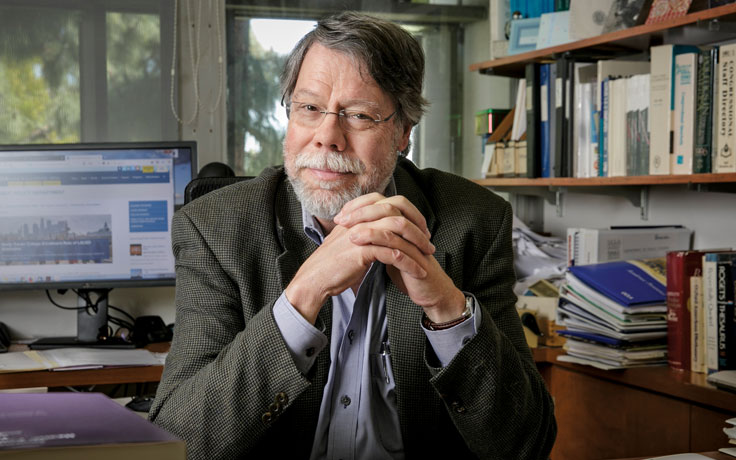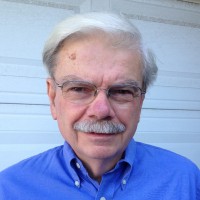FEDERALISM IS MESSY.
Power-sharing between Washington and the states makes Obamacare
possible. But this power-sharing also makes it vulnerable. Because of federalism, Obamacare will always be in danger.
Mark A. Peterson, an authority on American government and federalism
and a leading expert on health care legislation, considers Obamacare, more formally the Affordable Care Act, the most important advance in health protection since the creation of Medicare and Medicaid.
Peterson, professor of public policy, political science and law at UCLA and former chair of the Department of Public Policy, is finishing his third book, Hardball Politics, Hobbled Policy: Contexts, Choices and Consequences in U.S. Health Reform. It shows how intense political dynamics, as well as strategic and tactical choices by presidents, thwarted health care reform in the past but ultimately made Obamacare possible — in a context that also prompted legal and political attacks against it.
During a round of interviews in his corner office at the Luskin School of Public Affairs, Peterson, 62, gracious, lightly bearded and tall enough to play forward for the Bruins, spoke of his optimism, nonetheless, that ultimately the United States will have universal health insurance coverage like other developed nations — what many call Medicare for all.
Politics at a young age
Peterson’s fascination with politics and government began at his family’s dinner table. He was born in Washington, D.C., and grew up in suburban Garrett Park., Md. His watched the news during meals. When he was 10, his father, a section head at the National Cancer Institute, was invited to the University of Uppsala for a year. He took the family to Sweden. They had health care simply by virtue of being there. “Full access to a modern medical system,” Peterson said. “Universal coverage.”
Back home, he demonstrated against the Vietnam War. In 1973, he went west to attend Pomona College in Claremont. In succession came Watergate, the Yom Kippur War, the Saturday Night Massacre and President Richard Nixon’s resignation. Claremont seemed far away and isolated. Peterson transferred tothe University of Michigan, which was more politically active. But he resisted majoring in political science; he had other interests, including architecture. Finally, he gave in. As a student, he campaigned for a Democrat running for Congress, then became a precinct captain, ward chair and a deputy registrar.
Michigan did not register voters by party. “I registered a guy at his apartment,” he recalled, “and then, a few weeks later, I was in the Diag, the core of the central campus, and I heard a fife and drum group coming around the corner of the library, and I saw this fellow I had registered. He was in the Revolutionary Communist Youth Brigade, marching across the Diag, and I said to myself, ‘I’m not in Claremont anymore.’”
Peterson earned his A.B., A.M. and Ph.D. at Michigan. He went to Harvard as an assistant professor and ran its undergraduate program in government and political science for three and a half years. In 1993, he left for the University of Pittsburgh, where he was a professor of public affairs, political science and, in keeping with a growing interest, public health. From Pittsburgh, he came to UCLA. He has served twice as chairman of the Department of Public Policy and holds joint appointments to the Department of Political Science and the School of Law.
Money and public health
In addition to academic credentials, Peterson brought practical experience in both federalism and health care. While he was at Michigan, he took part in an intergovernmental analysis that traced the flow of money — and with it, power — throughout the federal government and the states. While he was at Harvard, he worked as a congressional fellow in the office of Sen. Tom Daschle (D-S.D.), where he became a legislative assistant for health policy. He participated in drafting the American
Health Security Plan of 1992, the Clinton administration’s proposal for comprehensive health care reform.
It went nowhere, as had President Harry Truman’s earlier proposal for national health insurance and a plan by Nixon and a group of Democrats to build an employer-based system and combine it with a public program. Bill and Hillary Clinton would fail, as well, in their effort to provide broader health coverage. Some states would expand coverage, but it was not until Barack Obama became president that anyone won approval for a health care plan designed to insure everyone in the United States.
Without federalism, Obamacare “probably would not have passed,” Peterson said. Federalism “derives from popular sovereignty. The Constitution starts with, ‘We, the people,’ and the theme in the social contract is that we, the people, have come together, and in this Constitution, we are granting certain powers and authorities to the federal government; we are granting certain powers and authorities to the state governments; and those powers that are not explicitly conveyed to the federal government are held in reserve by the states or the people.”
Federalism has been compared to a layer cake. More recently, with an increased diffusion in the flow of power, the metaphor has changed to a marble cake. “I joke in my class in American Political Institutions about dessert analogies,” Peterson said. He agrees with David K. Jones, an assistant professor at the Boston University School of Public Health, who has written that “ federalism is messy.” Members of the House of Representatives represent the interests of people in individual districts, while members of the Senate represent the interests of people in states as a whole. The House plan for Obamacare, for example, called for the sale of health insurance on a national exchange. Even some Democrats in the Senate, conservatives such as Ben Nelson of Nebraska and Joe Lieberman of Connecticut, “would have had a really hard time doing that,” Peterson said. “As long as there was a Senate, the Affordable Care Act probably wouldn’t have passed without having a greater role for the states.”
The Senate left it to states to establish their own exchanges. Senators expected most of them to do so. “They probably thought 40 or 45 states would set up exchanges, and that the federal government would have to come in and backfill for only five or seven, whatever it might be,” Peterson
said. But Republican states rebelled, and when enrollment opened, only 16 states had established exchanges. “The federal government had to ramp up and backfill more quickly than they thought,” he said, “and when the federal exchange launched and crashed, the impact was politically devastating.”
Because the Senate version of Obamacare became the foundation of the law, it deferred to the states in other ways, too. It left Medicare alone, except to close a gap in prescription coverage, but it expanded Medicaid, administered by the states, to increase coverage at lower income levels. When it established exchanges, it emulated a health care program in Massachusetts, which had a state exchange. The Massachusetts plan had been approved by a Democratic legislature and signed into law by Gov. Mitt Romney, a Republican, and it was up and running. “It was complex,” Peterson said. “There were lots of moving parts. But they had managed to do it. It expanded coverage. And it worked. There’s some evidence that people are now healthier in Massachusetts than comparable people in border states.”
That was proof of concept, Peterson said, and it was a uniquely Americanapproach. “[Supreme Court Justice] Louis Brandeis, in a famous dissenting opinion, talked about the wonders of the laboratory of democracy, where a bold state can try something, without doing any harm to anybody else, and see whether it works or not. This was federalism as the engine of innovation, and it was federalism as a way to accommodate diversity of views.”
Obamacare adopted the Massachusetts plan as its framework. Then it added and adapted. Alongside state exchanges, Obamacare built upon employer-based insurance, but modified it to allow children to stay on their parents’ insurance up to age 26. It forbade insurers to deny benefits because of pre-existing conditions. It required companies with 50 or more full-time employees to offer affordable insurance, and it said that all plans had to offer maternity, mental health and preventative health coverage. It provided government subsidies to help lower-income people buy insurance. To sustain the program financially, it mandated that everyone had to participate, including the healthy.
In this way, Obamacare became a collection of disparate reforms. “It meant that if you were trying to figure out what this thing did, you had to be aware of all those moving parts,” Peterson said. “It was incredibly complicated to explain to people. That is why President Obama and the Democrats had — and continue to have — such difficulty getting people to understand it.” The same principles that enabled the creation of Obamacare by giving the states a role in it, Peterson said, “also gave the platform and the authority to people at the state level to challenge it.” The states, which had been crucial to shaping and approving Obamacare, now became a path to resistance.
The attack on Obamacare
Congress passed the Affordable Care Act in 2010. Obama signed it on March 23.
It was attacked immediately.
First, in the courts. Opponents sued. “A large number of attorneys general went after it for being an unconstitutional federal overreach,” Peterson said. Ultimately the Supreme Court ruled that Obamacare was constitutional, but not its expansion of Medicaid. “With the Supreme Court decision,” he said, “there was even more confusion. Upwards of about 18 or so states have not expanded, although some of them are currently in negotiation with the Donald Trump administration about possibly expanding Medicaid — but only if they can impose work requirements on the recipients.”
Second, in Congress. By now, Obama’s party had lost control of the House. “Republicans, starting in January of 2011, held about 60 different votes,” Peterson said. “About a half dozen were on full repeal, and the rest were on various kinds of dismemberment. It didn’t go anywhere because
Democrats still had the Senate.” But then the states sent more Republicans to the Senate, and the Democrats lost control in 2014. The Senate enacted, along with the House, a full repeal. “But the president was still Obama,” Peterson said, “and he wouldn’t sign it. Then we got to the 2016 election, and Trump was on board with repeal — but then the Republicans realized, ‘Oh, my God, this is real. You can’t just suddenly say to 25 million people: ‘You’re not going to have health insurance.’ Or: ‘If you have a pre-existing condition, it’s not covered.’ It turned out that the Republicans had never formally sat down and developed a replacement plan, and when things started getting real, you started hearing, particularly in the Senate, ‘We don’t want to get rid of this pre-existing condition protection,’ and, ‘Having your kids on insurance until age 26 is not so bad.’ At the same time, from the right, the conservatives wanted to eviscerate Medicaid — not just the expansion but the program itself. So they were not able to do repeal and replace.”
Third, Obamacare came under attack from the Trump administration, which chipped away at it administratively. The mandate to have insurance imposed a fine. Unless individuals or families could show that the cost of insurance would be a prohibitive percentage of their income, they had to pay a penalty. “The Trump administration used administrative procedures to effectively suggest that the Internal Revenue Service ignore the penalty,” Peterson said. Ultimately, the House, joined by the Senate, passed the Tax Cuts and Jobs Act of 2017, which did away with the penalty altogether.
There were other dynamics as well. One was partisanship. When Obamacare passed, not a single Republican voted for it. “Of the something like 28 attorneys general who participated in lawsuits against the Affordable Care Act,” Peterson said, “all but one were Republicans.” And they were united in their antipathy toward Obama. “Obama was the ‘other,’” Peterson said. “He was the African American president. He also was a social activist. Without issues of race or anything else, Obama represented the liberal expansionist state.” Obamacare was “the heavy hand of government, the regulatory state, the interventionist state.” These divisions, Peterson added, “were deep and dark and tribal.” In Pew Research Center studies, he said, “something like 35% to 40% of Democrats thought Republicans were a threat to the future of the country, and something like 30 percent to 40 percent of Republicans thought Democrats were a threat to the future of the country. That’s pretty intense.”
Finally, confusion played a part. “At the time, I said to a friend who was high in the ranks of the Department of Health and Human Services that I thought the president should have a 15-minute televised speech once a week in which he’d say, ‘Tonight I’m going to speak to those of you who
have your health care insurance through your employer and tell you what the Affordable Care Act does for you.’ Next week would be, ‘Those of you who have children who are young adults and are not yet in jobs that are providing them with health insurance, let me tell you what this act will do for you.’ It would have been kind of the FDR fireside chat for different elements of health care reform.”
It did not happen.
Action moves to the states
It is Peterson’s guess that the states are going to become increasingly assertive in challenging Obamacare. Does this mean federalism will make lasting health care reform in the United States impossible?
“I don’t think so,” he said. “There are a couple of scenarios. One is that we end up for a period of time continuing to be unable to either sustainably expand coverage or restrain cost in the system and promote efficiency in the system. More and more resources will continue to be devoted to health care, lots of people will remain out, and disparities will be significant, if not worsened. But there will be a moment when a version of Medicare for all will be what makes the most sense and gets political traction. It’s going to take a while. It will take a lot of pain and some institutional disruption and collapse, but I don’t think it’s an outlandish notion.
“The other scenario is that we’ll continue spending twice as much as everywhere else, and we don’t reach a critical juncture. But I will be a UCLA optimist and think that, in fact, we will get closer to a more favorable resolution, rather than spin out of control. We’ll get some version of Medicare for all, and by that I mean the federal government will take on more responsibility for financing health care coverage for people and try to include everybody in it.”
Some Democrats in Congress, for example, have begun expressing an interest in expanding eligibility for Medicare and Medicaid. In late February, Sen. Tim Kaine (D-Va.) told The Los Angeles Times: “We need to come up with the next set of ideas about how to improve coverage and affordability.”
Indeed, it might be that states lead the way toward reform. Peterson said there might be a “new Massachusetts, in a different form, that provides the basis — or maybe even a compact of states. Who knows? We’re thinking way outside of the box now, but in 10 years, maybe there will be a compact of Western states that will do this together.”
Meanwhile, the nation will pay what Paul E. Peterson, a former colleague of Mark Peterson’s at Harvard, titled one of his books: The Price of Federalism. Federalism creates opportunities to fit policy to politics, Mark Peterson said. “But the price of federalism is all the ways in which rationality can be subverted by the marble cake that emerged over the 200 years of American history.
“The price of federalism,” he said, “is the messiness that goes with it.”

























